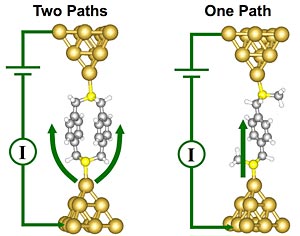It is common knowledge to scientists dealing with electronic circuits that fundamental laws such as ohm’s law govern the properties of electronic circuits. Efforts have been extended for several years to determine if these laws hold good when electronic circuits are diminished to the size of a single molecule.
 Atomic Level Imaging of Single Moleuclar Junctions with (I) Two pathways and (II) One Pathway (Credit: Brookhaven National Laboratory)
Atomic Level Imaging of Single Moleuclar Junctions with (I) Two pathways and (II) One Pathway (Credit: Brookhaven National Laboratory)
Scientists from the Brookhaven National Laboratory in conjunction with scientists from Columbia University have modeled the electronic circuit behavior at molecular level by employing computation tools.
Conductance is defined as the degree to which a circuit allows the flow of electricity. In a circuit that consists of two resistors connected in parallel, the conductance of the circuit is the simple sum of the resistances offered by each of the resistor path. It was found that fundamental quantum mechanics decide the laws that determine the flow of electrons in molecular scale circuits. In a circuit consisting of a single molecule, the molecule does not act like traditional resistors and instead allow the electrons to burrow through them. Also, when a molecular circuit provides two parallel pathways for the electron, the resulting wave-like movement of the electron alters the net conductance of the circuit such that the total circuit conductance of a two-pathway molecule is four times higher than a molecular circuit with a single pathway. This is a trait that nanotechnology experts have assumed but never been able to validate over the years. The scientists had to develop their own controllable nanoscale circuits to study the effects of quantum mechanics.
To build the molecular circuits, the team modified a scanning tunneling microscope (STM) to repeatedly keep a gold electrode and a sharp gold tip pressed and subsequently pulls them both apart. The breaking of this junction makes way for a gap wide enough to accommodate a molecule between the two gold pieces at a particular instance of time. The circuit when set, can be used to make measurements of conductance any number of times. The results of the study showed that the net conductance offered by molecular circuits with two parallel paths is only twice the conductance of single path molecular circuits.
The team is now studying effect of the molecule’s bonding with the electrodes and the consequence of using different metals.
Source: http://www.bnl.gov